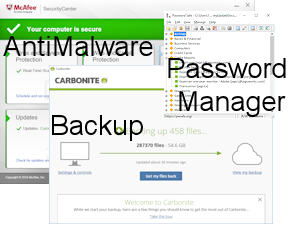Jan's Computer Basics:
Applications: Security & Utility
 There are many categories of special purpose programs that are generally called Utility Programs. Some of these just tweak the
user interface and some perform highly technical tasks.
There are many categories of special purpose programs that are generally called Utility Programs. Some of these just tweak the
user interface and some perform highly technical tasks.
The Security Programs that help keep the bad guys from messing with your computer and its data are the most important type of utility program.
Security Programs
To do a good job of keeping your computer safe from random visitors or from crime syndicates, you need several types of programs.
Types of security programs:
- Anti-malware: Continuously watches for incoming attacks. Scans regularly for hidden malware (a virus, trojan, worm or other intrusive software). Repairs many kinds of damage. Anti-virus is the old name for these programs but current versions deal with much more than just computer viruses.
- Firewall: Controls who gets into your computer from the Internet or other network connection.
- Anti-spam: Examines incoming email and sends known or suspected bad messages to a special folder, Spam or Junk.
| Purpose: |
|
| Major Advantage: |
|
| Major Disadvantage: |
|
Examples of security programs, some of which include several programs:
Norton Security Suite, Microsoft Security Essentials, Avira AntiVirus, Windows
Firewall, Norton 360, Trend Micro Internet Security Plus, Zone Alarm
See Wikipedia's article ![]() comparing various programs.
comparing various programs.
Utility Programs
There are many categories of utility programs, including security software. What is counted as a utility program depends on who is doing the counting! The usual definition is that a utility program is not application software that the user uses to create something, like a document or image, nor is it a game or a browser. It does something to way the computer looks or behaves, often in the background. [Some web sites that sell software include a lot more in their Utility category, including games(!), money management software, genealogy software, course management software, and many more.]
Over time, features and services that used to be available only through a utility program get included in the operating system or as part of the program the program was designed to modify. Nothing changes more and faster than the world of computers!
| Purpose: |
|
| Major Advantage: |
|
| Major Disadvantage: |
|
Examples:
- Parental control programs block access (especially for children) to web sites that are not suitable or are more likely to result in malware attacks - NetNanny, K9 Web Protection, some operating systems include some features.
- Encryption programs encode your data so that to read it the user must have the right key code. Some operating systems include some type of encryption. Could be for the whole disk, selected folders, or selected files.
- Password management software remembers all of your logon and password information so that you only have to remember how to get into the password software - one thing! The file that records your passwords is encrypted - Password Safe, Roboform, KeePass.
- Back-up and file synchronization software can automatically save a copy of your data or the whole computer's contents to DVDs, tape, or to a data site online. To be prepared in case a disaster happens, whether it is a security issue or a dead hard drive issue, you need a back-up copy of your important data - Windows Backup & Restore, Norton 360, Norton Ghost. Online file storage - Carbonite. File storage with synchronization: Dropbox, Box, Microsoft OneDrive, Google Drive
- Disk defragmenting software rearranges files so that all parts of the file are next to each other. The computer will scatter pieces of a file all over the disk, wherever there is some room. Defragmenting makes it easier for the computer to find and display the file - Windows Disk Defragmenter, Norton SpeedDisk.
See System Software: Utilities for more discussion.
